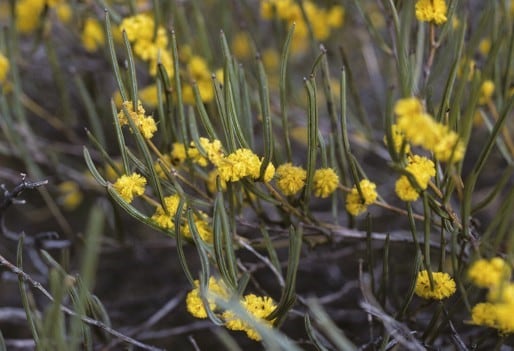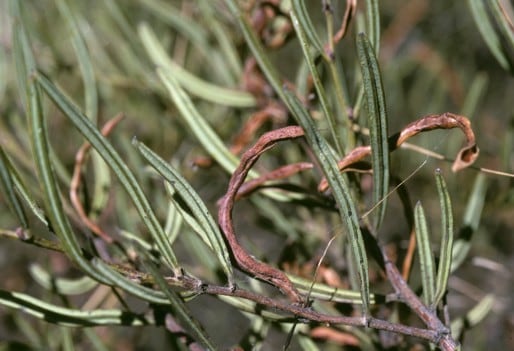Acacia tetraneura Maslin & A.R.Chapm.
WATTLE
Acacias of Australia
Family
Fabaceae
Distribution
A rare species, known only from a few specimens from the Bruce Rock area and SE of Hyden, south-western W.A.
Description
Shrub 0.3–0.4 m high, spreading, ±flat-topped. Branchlets glabrous or sparsely appressed-puberulous at extremities, resinous. Phyllodes erect, terete or flat, linear to narrowly oblong (when flat), mostly shallowly incurved, (2–) 3–7 cm long, 1.5–3 mm wide, mucronate, rigid, glabrous except pulvinus normally appressed-puberulous; nerves 4, prominent, flat-topped, broad, resinous; central nerve prominently raised when phyllodes flat; internerve spaces deeply furrowed when phyllode terete, ±glaucous. Inflorescences simple, mostly 2 per axil; heads ±subsessile, globular to shortly obloid, 5 mm diam., 13–20-flowered, light golden; bracteoles exserted in buds, acuminate, dark brown to blackish. Flowers 4-merous; sepals 1/2–2/3-united. Pods linear, shallowly constricted between seeds, straight to ±twisted, to 5 cm long, 2–3 mm wide, coriaceous-crustaceous, glabrous; margins broad. Seeds (few seen) longitudinal, obloid, turgid, 2–2.5 mm long, greyish brown, obscurely mottled; aril terminal.
Habitat
Grows on low hills in shallow loam over laterite and in rocky (granitic) clay in low heath.
Specimens
W.A.: Bruce Rock area, B.R.Maslin 1801 (CANB, K, MEL, PERTH).
Notes
Most closely related to A. lirellata which has phyllodes with more numerous nerves and moniliform or submoniliform pods; also related to A. cochlocarpa which differs by having phyllodes usually with more numerous nerves and coiled pods. The phyllode nerves, but not the phyllode form, are remarkably similar to those of A. sciophanes (sect. Plurinerves), which is a wispy shrub with pendulous branchlets and pedunculate heads of 5-merous flowers.
FOA Reference
Data derived from Flora of Australia Volumes 11A (2001), 11B (2001) and 12 (1998), products of ABRS, ©Commonwealth of Australia
Author
A.R.Chapman, B.R.Maslin
This identification key and fact sheets are available as a mobile application:
URL: https://apps.lucidcentral.org/wattle/
© Copyright 2018. All rights reserved.










